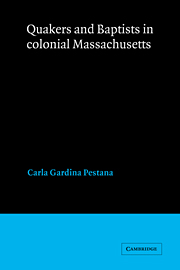6 - Boundaries between sectarians and others
Published online by Cambridge University Press: 22 October 2009
Summary
The establishment of two sects in colonial Massachusetts created alternative forums for popular spirituality where none had previously existed. For a generation, an established faith had offered the only opportunity for communal religious expression; now a pair of other choices rapidly became available. Making the decision to abandon orthodoxy, the apostate crossed over a boundary into sectarianism. Yet interaction among orthodox, Quaker, and Baptist took place on the borders between the three faiths, as colonists fought battles and worked for compromises.
In their dealings with sectarians, orthodox colonists freely distinguished between the two sects. In doing so, they revealed a fairly sophisticated grasp of the theological issues at stake. Decades of listening to orthodox preaching and reading the Bible had taught Bay colonists to differentiate between the relatively familiar faith of the Baptists and the more alien one of the Quakers. If the average colonist's commitment to religious homogeneity was less than unwavering, the majority did not vigorously support the development of religious toleration, either. Contrary to the standard interpretation, toleration was not an either/or proposition, but developed partially and unevenly. With time, the boundaries between all three groups would blur, signaling a major change in the organization of colonial life.
The initial creation of sectarian communities was an exercise in defining and crossing boundaries. By publicly declaring their departure from the established faith, Quakers and Baptists moved out of the orthodox fold. In organizing distinctive alternatives beyond the pale of orthodoxy, they introduced an unprecedented situation in which a trio of spiritual options existed. Having labored to forge these new communities, both sects were tenacious in the defense of the options they represented.
- Type
- Chapter
- Information
- Quakers and Baptists in Colonial Massachusetts , pp. 120 - 144Publisher: Cambridge University PressPrint publication year: 1991



